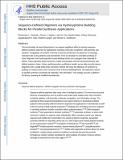| dc.contributor.author | Kanasty, Rosemary Lynn | |
| dc.contributor.author | Vegas, Arturo | |
| dc.contributor.author | Ceo, Luke | |
| dc.contributor.author | Maier, Martin | |
| dc.contributor.author | Charisse, Klaus | |
| dc.contributor.author | Nair, Jayaprakash K. | |
| dc.contributor.author | Langer, Robert S | |
| dc.contributor.author | Anderson, Daniel Griffith | |
| dc.date.accessioned | 2019-08-22T15:52:20Z | |
| dc.date.available | 2019-08-22T15:52:20Z | |
| dc.date.issued | 2016-07 | |
| dc.date.submitted | 2016-05 | |
| dc.identifier.issn | 1433-7851 | |
| dc.identifier.uri | https://hdl.handle.net/1721.1/122009 | |
| dc.description.abstract | The functionality of natural biopolymers has inspired significant effort to develop sequence-defined synthetic polymers for applications including molecular recognition, self-assembly, and catalysis. Conjugation of synthetic materials to biomacromolecules has played an increasingly important role in drug delivery and biomaterials. We developed a controlled synthesis of novel oligomers from hydroxyproline-based building blocks and conjugated these materials to siRNA. Hydroxyproline-based monomers enable the incorporation of broad structural diversity into defined polymer chains. Using a perfluorocarbon purification handle, we were able to purify diverse oligomers through a single solid-phase extraction method. The efficiency of synthesis was demonstrated by building 14 unique trimers and 4 hexamers from 6 diverse building blocks. We then adapted this method to the parallel synthesis of hundreds of materials in 96-well plates. This strategy provides a platform for the screening of libraries of modified biomolecules. Keywords: bioconjugates; fluorous synthesis; oligomers; sequence-defined polymers; siRNA | en_US |
| dc.description.sponsorship | National Institutes of Health (U.S.) (Grant EB000244) | en_US |
| dc.description.sponsorship | National Cancer Institute (U.S.) (Grant P30‐CA14051) | en_US |
| dc.language.iso | en | |
| dc.publisher | Wiley | en_US |
| dc.relation.isversionof | http://dx.doi.org/10.1002/anie.201602748 | en_US |
| dc.rights | Creative Commons Attribution-Noncommercial-Share Alike | en_US |
| dc.rights.uri | http://creativecommons.org/licenses/by-nc-sa/4.0/ | en_US |
| dc.source | PMC | en_US |
| dc.title | Sequence-Defined Oligomers from Hydroxyproline Building Blocks for Parallel Synthesis Applications | en_US |
| dc.type | Article | en_US |
| dc.identifier.citation | Kanasty, Rosemary et al. "Sequence‐Defined Oligomers from Hydroxyproline Building Blocks for Parallel Synthesis Applications." Angewandte Chemie International Edition 55, 33 (July 2016): 9529-9533 © 2016 WILEY-VCH Verlag GmbH & Co. KGaA, Weinheim | en_US |
| dc.contributor.department | Massachusetts Institute of Technology. Department of Chemical Engineering | en_US |
| dc.contributor.department | Massachusetts Institute of Technology. Department of Biological Engineering | en_US |
| dc.contributor.department | Harvard University--MIT Division of Health Sciences and Technology | en_US |
| dc.contributor.department | Massachusetts Institute of Technology. Institute for Medical Engineering & Science | en_US |
| dc.contributor.department | Koch Institute for Integrative Cancer Research at MIT | en_US |
| dc.relation.journal | Angewandte Chemie International Edition | en_US |
| dc.eprint.version | Author's final manuscript | en_US |
| dc.type.uri | http://purl.org/eprint/type/JournalArticle | en_US |
| eprint.status | http://purl.org/eprint/status/PeerReviewed | en_US |
| dc.date.updated | 2019-08-09T12:39:16Z | |
| dspace.date.submission | 2019-08-09T12:39:18Z | |
| mit.journal.volume | 55 | en_US |
| mit.journal.issue | 33 | en_US |
